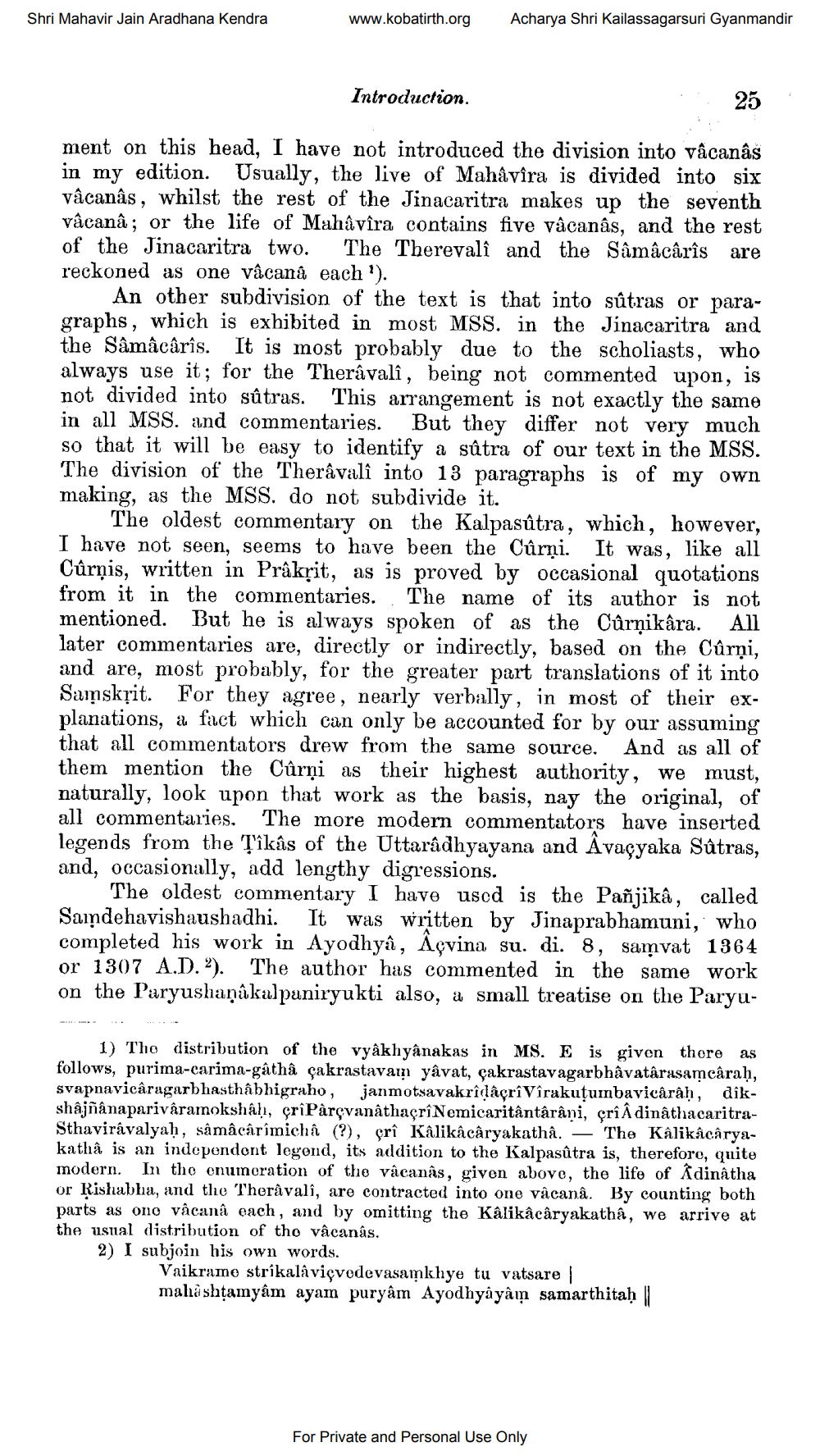________________
Shri Mahavir Jain Aradhana Kendra
www.kobatirth.org
Acharya Shri Kailassagarsuri Gyanmandir
Introduction.
25
ment on this head, I have not introduced the division into vacanâs in my edition. Usually, the live of Mahâvîra is divided into six vâcanâs, whilst the rest of the Jinacaritra makes up the seventh vâcanâ; or the life of Mahâvîra contains five vacanâs, and the rest of the Jinacaritra two. The Therevalî and the Sâmâcârîs are reckoned as one vacanâ each ').
An other subdivision of the text is that into sûtras or paragraphs, which is exhibited in most MSS. in the Jinacaritra and the Sâmâcârîs. It is most probably due to the scholiasts, who always use it; for the Therâvalî, being not commented upon, is not divided into sâtras. This arrangement is not exactly the same in all MSS. and commentaries. But they differ not very much so that it will be easy to identify a sâtra of our text in the MSS. The division of the Therâvalî into 13 paragraphs is of my own making, as the MSS. do not subdivide it.
The oldest commentary on the Kalpasútra, which, however, I have not seen, seems to have been the Cûrņi. It was, like all Cûrņis, written in Prakrit, as is proved by occasional quotations from it in the commentaries. The name of its author is not mentioned. But he is always spoken of as the Cûrņikâra. All later commentaries are, directly or indirectly, based on the Cûrņi, and are, most probably, for the greater part translations of it into Saskṣit. For they agree, nearly verbally, in most of their explanations, à fact which can only be accounted for by our assuming that all commentators drew from the same source. And as all of them mention the Cûrņi as their highest authority, we must, naturally, look upon that work as the basis, nay the original, of all commentaries. The more modern commentators have inserted legends from the s'îkâs of the Uttarâdhyayana and Âvaçyaka Sûtras, and, occasionally, add lengthy digressions.
The oldest commentary I have used is the Pañjikâ, called Saindehavishaushadhi. It was written by Jinaprabhamuni, who completed his work in Ayodhyâ, Açvina su. di. 8, samvat 1364 or 1307 A.D. 2). The author has commented in the same work on the Paryushaņākalpaniryukti also, a small treatise on the Paryu
1) The distribution of the vyâkhyânakas in MS. E is given thore as follows, purima-carima-gâthâ çakrastavam yâvat, çakrastavagarbhâvatârasamcâraḥ, svapnavicâragarbhasthâbhigraho, janmotsavakrîdâçrîVîrakuţuinbavicârâh, dîkshâjñânaparivâramokshaḥ, çrîParçvanathacríNemicaritântârâni, çrî dinâthacaritraSthavirávalyah, sâmâcârimichâ (?), çrî Kâlikâcâryakathâ. — The Kalikâcâryakatha is an independent leyond, its addition to the Kalpasûtra is, therefore, quite modern. In the enuncration of the vacanâs, given above, the life of Adinatha or Rishabha, and the Therâvali, are contracted into one vâcanâ. By counting both parts as one vâcanâ each, and by omitting the Kalikâcâryakathâ, we arrive at the usual distribution of tho vâcanâs. 2) I subjoin his own words.
Vaikrame strikalâ vicvodevasamkhye tu vatsare | mahashtamyam ayam puryâm Ayodhyâyâm samarthitaḥ
For Private and Personal Use Only




